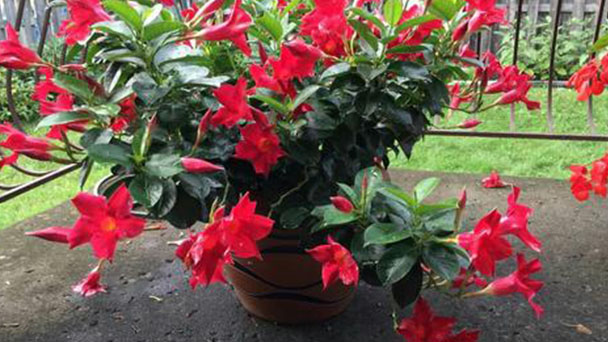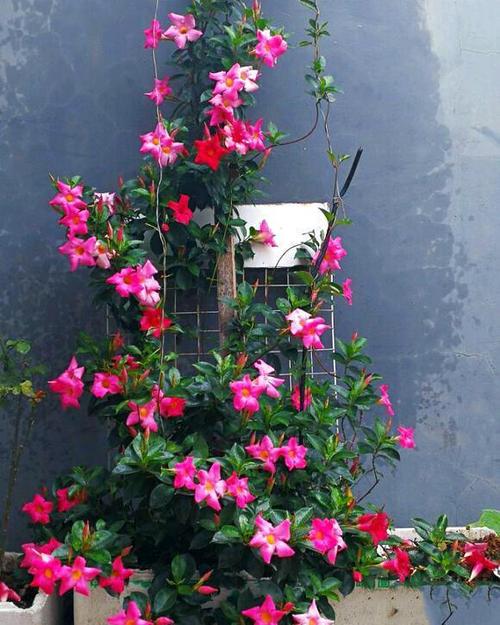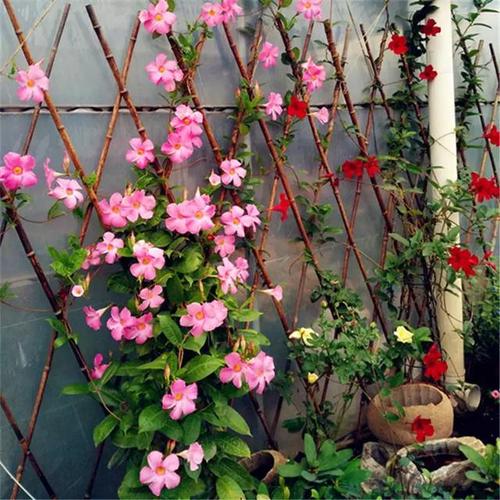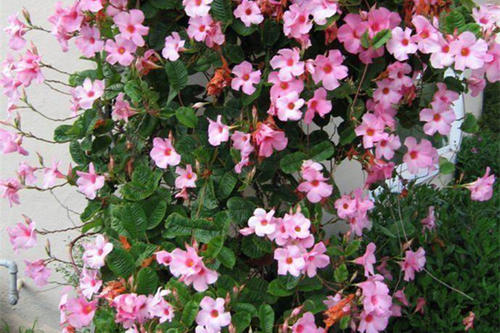Mandevilla (Rocktrumpet) profile
Written by Maggie
Aug 23 2021

Mandevilla (Rocktrumpet) is a new type of vine, a perennial evergreen plant of oleander family.Mandevilla's soft, pliable stems spiral up the trestle, and its large, straight, pink trumpet-like flowers can reach 6-8 cm in stems. Mandevilla is known as the Queen of Tropical Vines, with flowers ranging from pink, peach and bright red from early spring to late fall. Mandevilla prefers warm and wet conditions, but does not branch well. During the flowering period, Mandevilla often presents a grand situation of more flowers than leaves. When the breeze hits, the pungent fragrance makes people relaxed and happy, hence the elegant name of "Mandevilla".
Mandevilla picture

Mandevilla info
| Botanical Name | Mandevilla spp |
| Common Names | Mandevilla, rocktrumpet |
| Plant Type | Vine, perennial, annual |
| Sun | Full |
| Hardiness Zones | 10–11 (USDA) |
| Flower color | Pink, red, white |
| Native Area | North America, Central America, South America |
| Mature size | 3–20 ft. tall, up to 20 ft. wide |
Morphological characteristics of Mandevilla
Mandevilla is a perennial evergreen vine of the Oleander family.
Leaf
Leaves of Mandevilla are elliptic, large, wrinkled, sub entire, dark green, glossy, apex acute, leathery; The color is bright, funnel-shaped, mostly dark pink; Beautiful and unique branches, branches soft, can do a variety of modeling. Double glandular vine from early spring to late autumn flowers constantly, flowers from the bottom to open all the time, the color of the flowers from spring to summer more and more deep, more and more gorgeous, give a person with the feeling of rich and rich flowers, ornamental value is very high, love.
Flowers
Mandevilla has armpit flowers with funnel-shaped corolla in red, peach, golden-red, pink and other colors.
Mandevilla flowers mainly in summer and fall, but can also flower in other seasons if properly maintained.
The ecological habits of Mandevilla
Mandevilla (Rocktrumpet) likes warm, humid and sunny environments. It can also be placed in a slightly shaded place, but the light is not enough to reduce the flowering.
The optimum temperature for mandevilla growth is 20-30 ℃, and it has strong adaptability to soil, but the sandy loam with rich humus and good drainage is preferred.
How to grow and care for Mandevilla
Light and temperature
The optimal illumination intensity is 10,000-20,000 Lux. They are fond of warm and sunny environments, and are not cold resistant. The growth temperature is 20℃ ~ 30℃, and the growth is inhibited when the outdoor temperature is lower than 7.5 °C. Beijing area should be indoors in indoor winter, winter may fall leaves, until spring bloom again.
Moisture and humidity
Too dry soil affects fertilizer absorption, and too wet soil can cause root death or other diseases. Especially in winter, you need to reduce watering and keep the soil dry.Increase water in summer to prevent the soil from drying out completely. Outdoor cultivation should not be planted in too low-lying places, so as not to water caused by hypoxia and poor growth. The optimum relative humidity of air is 70-80%, which should be less than 50%.
Cultivation substrate
Mandevilla (Rocktrumpet) has strong adaptability to the soil, and the basin soil needs to be well drained, and the matrix with the addition of amendments and humus is better.
Indoor potted north usable rot leaf soil to add a small amount of coarse sand, the south can use pond mud, peat soil, river sand to press 5:3:2 mixed preparation. In the growing period, it can be appropriate amount of topdressing compound fertilizer 3-5 times, but should control the amount of nitrogen fertilizer, so as to avoid excessive growth of nutrition and affect reproductive growth, so that the flowering reduction. In the maintenance process, to properly control the watering, in order to form a developed root system.
Fertilization
Rational fertilization is needed in the Mandevilla vigorous growth period of spring and summer. Balanced slow-release fertilizer can be applied to the potted soil, followed by liquid fertilizer every 7-10 days. In general, the ratio of nitrogen, phosphorus and potassium balanced compound fertilizer is applied in spring, such as 15-15-15, twice a week, about 150ppm each time; In late spring or early summer, 150ppm phosphorus fertilizer, such as 10-20-10, can be added to promote flowering. When serving the pot, add some slow - release fertilizer is also possible. Burning symptoms at leaf tips, or black spots on the top and sides of leaves, indicate a possible lack of fertilizer.
Prune and transplant
After the flowering period, Mandevilla (Rocktrumpet) can be pruned. If it is a biennial plant, it can be lightly cut, pruning is mainly for shaping. Perennial plants can be strongly pruned in spring to promote the germination of strong new branches.
Occasionally removing growing mandevilla helps maintain the shrubby shape of the plant, promotes branching, and makes the plant fuller.
Highly growing varieties tend to overgrow pots, causing a lack of fertilizer, resulting in yellowing of lower leaves and non-flowering. As soon as possible, remove the old support and wrap the straggling branches around the new support.

9 Tips about how to grow and care for Mandevilla
The way Mandevilla propagates
Mandevilla (Rocktrumpet) can be propagated by seeding, cuttings, or by tissue culture.
When sowing, the temperature is required to be between 18 and 23°C, and it is generally carried out in spring. Cuttage is the most common method, often in late spring or early summer selected half lignified branches, a general internode used as a cuttings. Its cutting rooting time is longer, want 1 month above, dip in raw root powder can accelerate rooting.
Disease & pest control in Mandevilla
Disease control
The diseases are mainly leaf diseases such as leaf spot and leaf blight caused by tailospora, and root rot and stem rot caused by fusarium. Carbendazim, mancozeb and other drugs can be used to control the disease in the early stage.
Prevention of root rot mainly involves selecting a well-drained substrate, watering it alternately, and placing the plant in a bright, hot place.
Pest control
Red spider and whitefly are the pests with the greatest harm, which can be prevented by imidacloprid.
Read more about Mandevilla Care.
Mandevilla's distribution area
Mandevilla is found in tropical America.
Mandevilla toxicity
All parts of mandevilla plants are toxic to people and animals when ingested. And sap from the plants can cause skin irritation, as well as allergic reactions in those who are sensitive to mandevilla species.
Symptoms of poisoning
Symptoms of poisoning by ingestion include upset stomach, nausea, vomiting, diarrhea, and sores around the mouth. And symptoms from skin contact with the sap include redness, pain, itching, and sores. Most cases are mild, but it's still important to contact a medical professional if you suspect poisoning.
Mandevilla varieties
There are more than 100 species within the Mandevilla genus, including:
Mandevilla sanderi: Commonly known as Brazilian jasmine, this species is fast-growing and can reach up to 15 feet tall with twining, woody stems and large pink-red blooms.
Mandevilla boliviensis: Also known as white mandevilla, this species is notable for its white blooms; it can grow between 3 and 10 feet tall with a 3- to 6-foot spread.
Mandevilla laxa: Known commonly as Chilean jasmine, this species produces masses of heavily scented white flowers and can reach up to 20 feet tall.
Mandevilla landscaping purposes
Place: indoor potted Mandevilla (Rocktrumpet) should be placed in a bright place with a certain scattering of light. We must pay attention not to put the powder palm in the environment with strong direct sunlight. Mandevilla is resistant to stress and is less susceptible to disease, so it can be protected against by spraying it once a month during the growing season.
Mandevilla can be used as indoor balcony viewing, its tendrines naturally strong, and can be in the indoor sunshine of the balcony potted ornamental. During the flowering period, the big flowers compete with each other in red and pink, and the pungent fragrance makes people relaxed and happy.
Mandevilla can also be used for outdoor viewing. It likes strong light and has strong heat resistance, so it is suitable for cultivation in summer courtyards in the north and south. Mandevilla can be used for beautifying small courtyards such as containers, fences, trellises and rooftops to make the courtyards full of tropical exotic atmosphere.

Latest Updated
- Benefits of Bugleweed - 7 Science-backed Health Benefits
- Bugleweed Dangers & Side Effects - Is It Poisonous?
- How to Plant Evergreen Trees - What You Should Know
- When to Plant Evergreens - Grow Guide for Evergreen Trees
- 12 Wonderful Evergreen Shrubs for Your Garden
- 12 Popular Evergreen Plants with Pictures for Beginners
- When And How To Prune A Lilac Bush Like a Pro
- How to Grow & Care for Lilac Vine (Hardenbergia Violacea)
- Japanese Lilac Tree (Syringa Reticulata) Care & Propagation Guide
- Shumard Oak Pros and Cons - What to Know
Popular Articles
- Winter maintenance of Antirrhinum Majus
- How to Grow Terminalia Mantaly Tree
- How to Grow and Care for Crossostephium Chinense
- How to grow Antirrhinum Majus in spring
- Peristeria Elata (Dove Orchid) Profile: Info & Care Guide
- Underwatered Snake Plant (Sansevieria Trifasciata) - Signs And How To Fix
- How to Care for Brazilian Jasmine Plant (Mandevilla Sanderi)
- How to Grow & Care for Graptopetalum Purple Delight in Summer
- Rosa Chinensis (China Rose): Plant Growing & Care Tips
- How to Care for Baby Sun Rose (Aptenia Cordifolia)